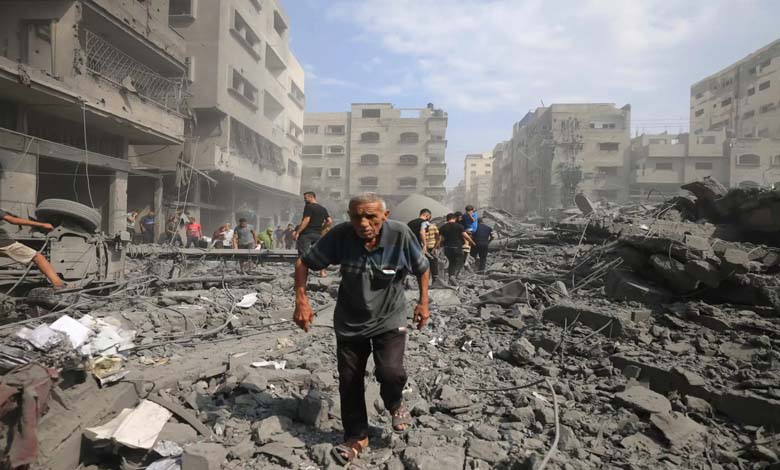The Second Anniversary of the War: Terrifying Losses Beyond Numbers in Gaza

Two years into the Gaza war, time itself seems unnecessary to mark the anniversary. The ruins remain, death lingers, and the suffering continues unabated.
The impact of Israel’s war on Gaza is starkly reflected in data released by the United Nations Relief and Works Agency for Palestine Refugees (UNRWA) to mark the second year of the conflict.
-
After 74 Years… UNRWA Forced to Leave Its Headquarters in Jerusalem
-
The Absence of an Alternative to UNRWA Fuels Debate between Israel and the UN
According to the UNRWA’s fact sheet, more than 66,000 Palestinians — including over 18,000 children — have been killed in Gaza since October 7, 2023. The Gaza Ministry of Health reported an even higher figure of more than 67,000 deaths and nearly 170,000 injuries.
On that day, at the end of the Jewish holiday of Sukkot, Hamas launched an unprecedented surprise attack from Gaza on southern Israel, killing around 1,200 people and taking more than 200 hostages, 48 of whom remain in captivity, with about 20 believed to be alive.
-
Israel’s Insistence on Banning UNRWA: What Does This Mean for Palestinians?
-
Born from the “Nakba”: What is UNRWA?
The United Nations highlighted devastating figures: nearly all Gaza residents have been displaced multiple times; about 80% of buildings have been damaged or destroyed; over 98% of agricultural land is now inaccessible; 455 malnutrition-related deaths have been recorded, including more than 150 children; and 660,000 children have been forced out of school for a third consecutive year. Nearly 92% of schools require major reconstruction or total rebuilding.
The war also wiped out 90% of Gaza’s water, sanitation, and hygiene infrastructure, leaving half of all homes without soap and over 500,000 women and girls without hygiene products.
-
UNRWA: “Looting” Operations Hamper Aid Delivery in Gaza
-
Netanyahu Proposes Full Reoccupation of Gaza and Removal of UNRWA
The Palestinian Ministry of Health stated that the devastation cannot be captured by numbers alone. Gaza’s healthcare system is on the verge of total collapse. Of the 36 hospitals that existed before the war, 34 have been destroyed or severely damaged, and more than 400 documented attacks have targeted hospitals, medical staff, and ambulances.
About 150 ambulances have been destroyed. Medical teams work under horrific conditions — often without anesthesia, electricity, or supplies. The few partially functioning hospitals, such as Al-Shifa, Al-Ahli, and Nasser, are overwhelmed far beyond their capacity.
-
UNRWA warns: Gaza witnesses the largest displacement of Palestinians since 1948
-
For the First Time in the Middle East: UN Officially Declares Famine in Gaza
Last month, a United Nations independent inquiry concluded for the first time that Israel had committed “genocide” against Palestinians in Gaza — a finding consistent with the assessments of genocide experts and human rights organizations. Israel has denied all accusations of genocide, restrictions on aid, and child starvation.
In August, a UN report officially declared a state of famine in Gaza, revealing that 500,000 people are enduring “catastrophic hunger.” UN Under-Secretary-General for Humanitarian Affairs Tom Fletcher stated that the famine could have been completely avoided if not for Israel’s “systematic obstruction” of food aid deliveries.
-
“I can’t walk anymore”: When journalists, the hungry, and medics collapse in Gaza
-
Israel Punishes UN over Gaza Operations: Three Visas Denied
UN agencies describe the allowed humanitarian aid as “a drop in the ocean,” insufficient to meet even basic needs.
According to the Palestinian news agency WAFA, over 1.9 million people — more than 80% of Gaza’s population — have been forcibly displaced, many of them multiple times. In March, a large-scale military offensive forced 1.2 million residents to flee Gaza City within days.
In July, Israel approved a plan to gradually reoccupy the entire Gaza Strip, starting in the north. As of now, 88% of Gaza’s land — approximately 317 square kilometers — is under evacuation orders.
-
Bloody Morning in Gaza: 31 Killed in Israeli Strikes Including Women and Children
-
Palestinian political analyst: Gaza’s humanitarian situation is catastrophic and international pressure falls short of addressing the crisis
Beyond the human catastrophe, Gaza faces a long-term environmental disaster. The United Nations Environment Programme (UNEP) warned that repairing Gaza’s environmental damage could take decades. Clean water is nearly nonexistent, sewage systems have collapsed, and groundwater and coastal waters are heavily contaminated.
UNEP reported that 97% of Gaza’s tree crops, 95% of greenhouses, and 82% of seasonal crops have been destroyed, rendering local food production nearly impossible. Of Gaza’s estimated 250,000 buildings, 78% have been damaged or destroyed, generating over 61 million tons of debris — 15% of which may be contaminated with asbestos, chemicals, or heavy metals.
-
Israel in the Crosshairs of British Justice: The 800 Memo Corners Tel Aviv
-
Gaza Aid: Sudden Resignation of Director of the New Mechanism
Air, water, and soil pollution now pose serious long-term health threats, especially to children.
The education sector has also been decimated: more than 179 public schools have been destroyed, over 100 UNRWA schools damaged, and 20 higher education institutions severely affected. Since the start of the war, more than 18,000 schoolchildren, 1,300 university students, and 1,000 teachers have been killed. As a result, more than 630,000 students are deprived of their basic right to education.












